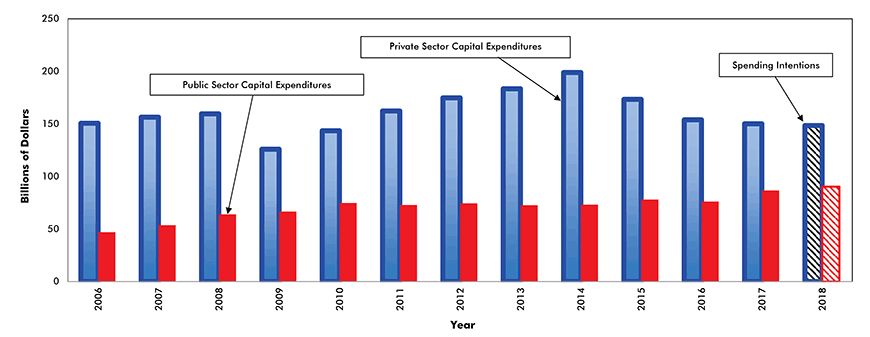After posting a modest 3% year-over-year gain in 2017, private and public capital spending plans slowed to under 1% in 2018 according to Statistics Canada’s annual survey of non-residential capital and repair expenditures (capex).
This marginal increase in total capex was driven by a 4.1% increase in public spending that more than offset a projected 1.1% decline in private spending in Canada. This pattern was reinforced by the most recent Business Development Bank of Canada’s Survey of 2018 Investment Intentions.
The Bank’s national survey of 4,019 business owners with one to 499 employees reported that Canadian entrepreneurs planned to reduce their spending on plant and equipment by 7.3% following a 1.9% decline in 2017.
Over the past four years, private sector capital spending has contracted by more than 25% largely on account of an oil-price-induced drop in spending on oil and gas extraction to its lowest level since 2009.
Given the federal government’s passive support for pipeline construction projects that would enable more Alberta oil to be shipped to either coast and British Columbia’s efforts to stop the expansion of Kinder Morgan’s Trans Mountain Pipeline between Hargreves B.C. and Burnaby B.C., it is not surprising that planned capital spending on oil and gas exploration dropped to $3.9 billion in 2018, down 5% from 2017 and 56% below its peak of $8.9 billion in 2013.
Excluding energy, private sector capital spending plans in Canada increased by 2.4% y/y in 2018. This projected gain, the first since 2014, was driven in large part by a 6.2% y/y rise in capex by manufacturers together with gains in planned spending by firms in real estate, rental and leasing, transportation and warehousing, and retail.
It is worth noting that the increase in capital spending by manufacturers in 2018 follows back-to-back declines in the previous two years and it is consistent with the gradual increase in the sector’s operating rate to a seventeen year high of 86.1%.
Across the country, total capital spending intentions increased in five of the ten provinces, led by Ontario. According to the Capex survey, spending plans in Canada’s largest province are projected to increase by 7.8% this year largely due a 17.4% y/y gain in government-driven spending accompanied by a marginal 2.5% rise in private sector capital spending intentions.
Following a 3.2% rise in 2016, the combination of stronger private sector investment plans (+5.4%) and sustained public sector spending boosted total capex spending plans to increase by 5.1% in 2018, the strongest rise since 2012.
Other provinces where capex spending intentions posted gains include British Columbia (+1.2%), Manitoba (+2.2%) and New Brunswick (+2.1%). The lingering impact of the collapse in oil prices which dragged down capex in Alberta also caused spending in Newfoundland and Labrador to retreat by a breathtaking -27.8% this year following a somewhat more modest 9.2% decline in 2017.
The fact that the major contributor to the marginal (+0.8%) increase in 2018 capital spending plans in Canada was a pre-election boost to public sector capital spending in Ontario and Quebec that just offset a further contraction in private sector investment intentions does not bode well for future capital spending for several reasons.
First, the lack of clarity surrounding the federal government’s recently announced Impact Assessment Agency adds an additional layer of regulation to an already very expensive process and heightens the uncertainty firms face when seeking approval of a major energy project.
Second, the recent cuts to U.S. corporate taxes and the ability of U.S. companies to accelerate the write-off of their investments place firms in Canada at a serious competitive disadvantage.
Third, as noted above, the persisting efforts by the B.C. government to block the Kinder Morgan Pipeline expansion combined with the cancellation of the Energy East Pipeline will serve as an ongoing deterrent to new investment.
Fourth, Ontario’s relatively high hydro rates place its energy-intensive manufacturing sector at a significant competitive disadvantage. Finally, the uncertain future of the North American Free Trade Agreement will likely cause firms to put their major investment plans on hold until they have a clearer view of Canada’s longer term trade prospects.
Non Residential Capital Expenditures – Private vs Public

Chart: ConstructConnect — CanaData.











Recent Comments
comments for this post are closed